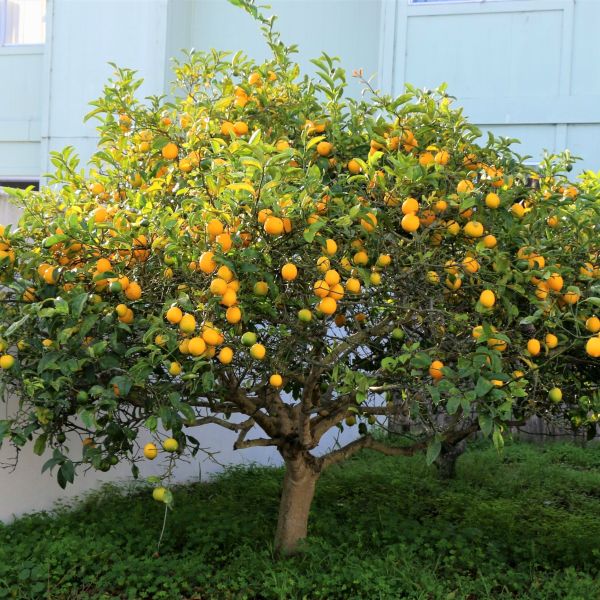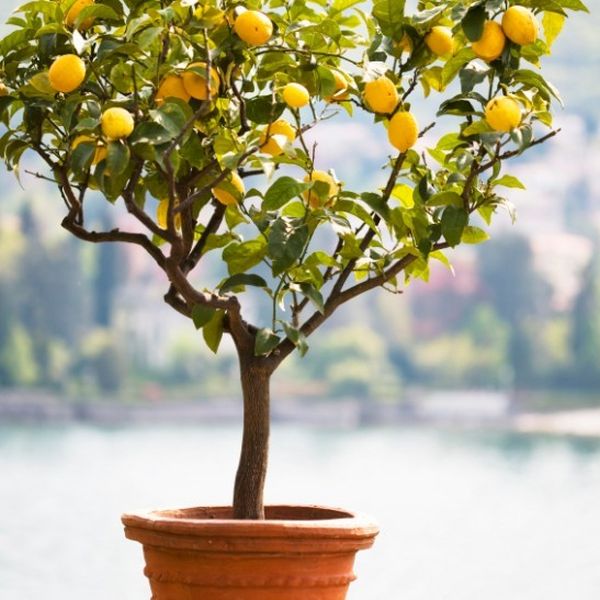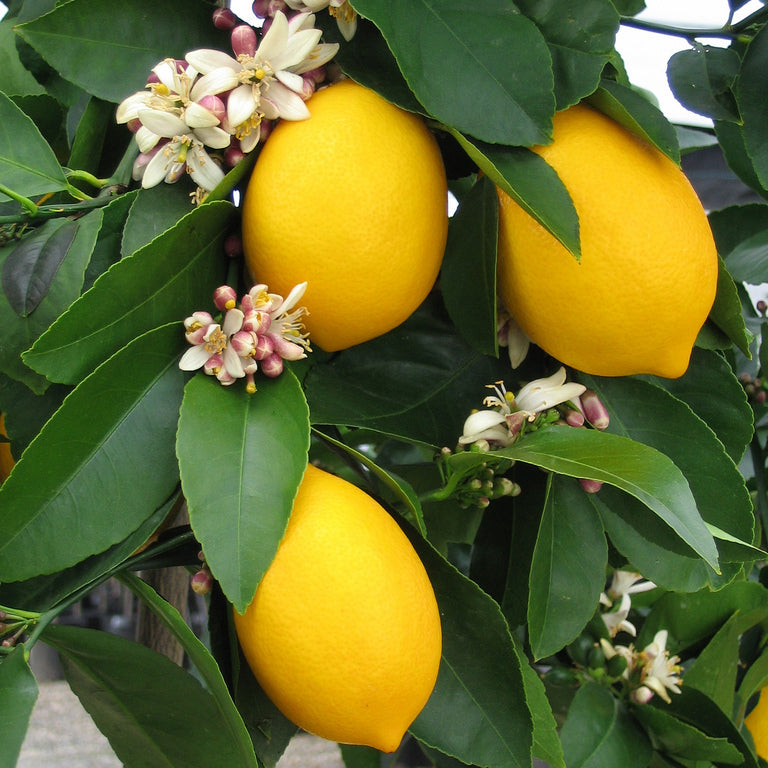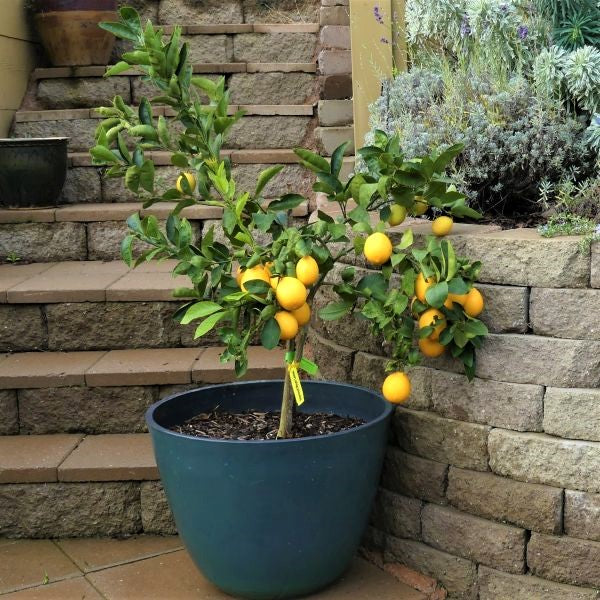Improved Dwarf Meyer Lemon Trees
Citrus limon 'Meyer Improved'
- Stay Protected with Plant Sentry ™
Improved Dwarf Meyer Lemon Trees - #3 Container 2-3 Feet is backordered and will ship as soon as it is back in stock.
Plant Sentry™
Plant Sentry™

Plant Sentry™ Protected
Your order is protected by our compliance system that:
- Prevents restricted plants from shipping to your state
- Ensures plants meet your state's agricultural requirements
- Protects gardens from invasive pests and diseases
Delivery and Shipping
Delivery and Shipping
Delivery and Shipping
Fast, Safe Plant Delivery
Ships in 3-4 business days • Tracking provided • Weather protected
| Under $50 | $9.99 |
| $50 - $99.99 | $14.99 |
| $100 - $149.99 | $16.99 |
| $150 - $198.99 | $24.99 |
| $199+ | FREE |
✓ Zone-specific timing • ✓ Professional packaging • ✓ Health guarantee
Understanding Plant Options
Nature Hills offers plants in two main formats:
- Container Plants: Grown in pots with soil, sized by container volume and plant age
- Bare Root Plants: Dormant plants without soil, sized by height measurements
Container Plant Sizes
Container sizes indicate plant age and growing capacity rather than liquid volume equivalents. Our containers follow industry-standard nursery "trade gallon" specifications, which differ from standard liquid gallon measurements.
Young Plants (6 months to 18 months old)
| Container Size | Actual Volume | Metric Equivalent |
|---|---|---|
| 2" x 2" x 3" | 0.18 - 0.21 dry quarts | 0.20 - 0.23 dry liters |
| 4" Container | 0.31 - 0.87 dry quarts | 0.35 - 0.96 dry liters |
| 4.5" Container | 0.65 dry quarts | 0.72 dry liters |
| 6" Container | 1.4 dry quarts | 1.59 dry liters |
| 1 Quart | 1 dry quart | 1.1 dry liters |
| 5.5" Container | 1.89 dry quarts | 2.08 dry liters |
Established Plants (18 months to 2.5 years old)
| Container Size | Actual Volume | Metric Equivalent |
|---|---|---|
| 2 Quart | 2 dry quarts | 2.2 dry liters |
| #1 Container | 2.26 - 3.73 dry quarts | 2.49 - 4.11 dry liters |
| 5" x 5" x 12" | 3.5 - 4.3 dry quarts | 3.85 - 4.74 dry liters |
Mature Plants (2-4 years old)
| Container Size | Actual Volume | Metric Equivalent |
|---|---|---|
| #2 Container | 1.19 - 1.76 dry gallons | 5.24 - 7.75 dry liters |
| #3 Container | 2.15 - 2.76 dry gallons | 8.14 - 12.16 dry liters |
Large Plants (3-5 years old)
| Container Size | Actual Volume | Metric Equivalent |
|---|---|---|
| #5 Container | 2.92 - 4.62 dry gallons | 12.86 - 20.35 dry liters |
| #6 Container | 5.25 - 6.01 dry gallons | 23.12 - 26.42 dry liters |
| #7 Container | 5.98 - 6.53 dry gallons | 26.34 - 28.76 dry liters |
Bare Root Plants
Bare root plants are sold by height from the root system to the top of the plant. Plants may exceed minimum height requirements.
Common Sizes:
- Trees: 1 foot, 2 feet, 3 feet, 4 feet, 5 feet, 6 feet
- Shrubs & Perennials: 1 foot, 18 inches, 2 feet
Important Notes
Container Volume Specifications
- Trade Gallon Standard: Our containers follow industry-standard "trade gallon" specifications established by the American National Standards Institute (ANSI Z60.1) for nursery stock
- Volume Variations: Actual soil volume may vary due to plant root systems and growing medium settlement
- Age Indicators: Container size primarily indicates plant age and maturity rather than liquid volume equivalents
Growing Conditions
- Plant size can vary based on variety and growing conditions
- Container size helps indicate plant maturity and establishment level
- Larger containers generally mean more established root systems and faster landscape establishment
Seasonal Availability
- Bare root plants are available seasonally when dormant
- Container plants are available throughout the growing season
- Specific varieties may have limited availability in certain sizes
Questions?
For questions about specific plant sizes or availability, please contact our plant experts who can help you choose the right size for your landscape needs.
Plant Highlights
Improved Dwarf Meyer Lemon Trees highlights at a glance!
-
Botanical Name
-
Brand
-
Growth RateModerate
-
Mature Height
-
Mature Width
-
Leaf Color
-
Flower Color
-
Fall Color
-
Pollinator FriendlyYes
-
Pollinator Required
-
Bloom PeriodLate Spring, Early Summer, Late Summer, Early Fall, Late Fall
-
FragrantYes
Characteristics
Where To Plant
When To Prune
- Late Spring
Water & Moisture Needs
- Moderate
Sunlight Needs
Soil Needs
- Well Drained
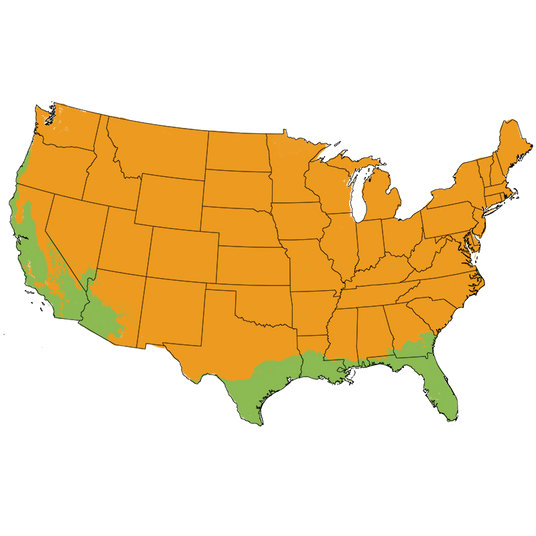
Growing Zones
Grow Citrus Anywhere!
Grow your very own lemons at home with the exceptional Improved Dwarf Meyer Lemon Tree (Citrus limon 'Meyer Improved')! This compact, fruit-laden Citrus plant is prized for its fragrant blooms, sweeter fruit, and indoor-outdoor adaptability!
This natural dwarf is expertly grafted to resist the Tristeza virus and thrives in containers or in the ground in warm climates. As the top homegrown Citrus tree in the U.S., Meyer Lemons are a favorite for edible landscaping, patio gardening, and container citrus groves.
Smaller in stature but mighty in production, the Improved Dwarf Meyer Lemon has an upright, bushy form with glossy, dark green leaves and delightfully perfumed white blossoms touched with purple at the base. It produces medium-sized fruit with a smooth yellow-orange rind and juicy flesh that tastes like a cross between a traditional Lemon and a Mandarin Orange.
These Lemons are less acidic and sweeter than grocery store varieties, and they're rarely stocked in stores because of their thin skin. That means home growers are in for a Citrus treat like no other!
Perfect for if you're into edible landscaping, patio gardening, or just love the idea of harvesting your own homegrown Citrus year-round, the Improved Dwarf Meyer Lemon Tree is the perfect choice for fragrant flowers and abundant fruit!
>>Jump to Planting & Care Instructions
Key Features
- Naturally dwarf size for containers or in-ground growing
- Fragrant white blossoms with purple tints
- Heavy fruit production year-round
- Sweet, less acidic lemon flavor with a hint of orange
- Compact, evergreen foliage with tropical appeal
- Grafted to resist Tristeza virus
- Rarely available fresh in stores. Best grown at home
- Suitable for container gardening or edible landscaping
- Hardy in USDA Zones 9-11 (indoor/outdoor adaptable)
Landscaping Uses
This versatile, evergreen Citrus tree adapts well to life on patios, balconies, or sunny indoor spaces when grown in containers. This dwarf Lemon tree stays compact, growing about 4-6 feet tall in containers or up to 10 feet in the ground with pruning. It fits beautifully in small gardens, balconies, patios, or as a show-stopping container specimen!
- Perfect for container gardening on sunny patios or balconies
- Use as an evergreen focal point or citrus hedge in warm zones
- Ideal for edible landscaping and orchard gardens
- Create a tropical feel with its lush foliage and fragrant blooms
- Grow indoors during winter for year-round fruit and fragrance
- Line pathways or fences with these dwarf Citrus charmers
Care and Maintenance
Hardy in USDA growing Zones 9-11 outdoors, it can be moved inside to overwinter in cooler climates. The Improved Dwarf Meyer Lemon is a broadleaf evergreen Citrus tree that thrives in containers or in the ground in warm, sunny locations. It's a low-maintenance fruiting tree with year-round appeal.
- Planting Time: Spring or fall in warm climates; any time in containers
- Sun Needs: Full sun (8+ hours daily); bright indoor window in winter
- Soil Needs: Well-drained, acidic potting mix (pH 6.0-6.5); add 25% pathway bark for structure in pots; avoid clay or compacted soil, and Citrus cannot grow in soggy soil.
- Moisture Needs: Let soil dry slightly between waterings; avoid standing water; use the Finger Test to check soil moisture
- Arborist Mulch: Use a 3-4 inch layer around in-ground trees to retain moisture and insulate roots; compost also supports healthy growth
- Fertilization Needs: Feed quarterly with an acid-based citrus fertilizer like Dr. Earth Acid Lovers Organic Fertilizer
- Pruning Info: Prune lightly to shape, remove crossing branches or inward growth, and open the center for airflow; deadhead blooms only if needed for tidiness
- Renewal Pruning: Not necessary unless reshaping for compact form
- Special Needs/Perks/Growing Tips and Tricks For Success:
- Deer and rabbit resistant
- Grafted for virus resistance
- Excellent for urban environments
- Handles high humidity and heat well
- Pollination Needs: Self-pollinating, but indoor hand-pollination (lightly shaking blooms or dabbing with a paint brush) can increase yield
Let the Sunshine In With Homegrown Citrus Joy
Why wait for supermarket lemons when you can enjoy your own fragrant blooms and fresh-picked fruit from the comfort of your patio, balcony, or living room? The Improved Dwarf Meyer Lemon Tree brings a juicy burst of sunshine into your everyday life, and fits beautifully into container gardens or edible landscapes.
Whether you're sipping Meyer lemonade, zesting up your meals, or simply enjoying the sweet citrus aroma in your home, this tree is a must-have citrus companion.
Buy your new lemon factory now, and Nature Hills will ship it right to your doorstep!
Frequently Asked Questions
Can I grow a Meyer Lemon Tree indoors year-round?
Yes! As long as it receives 8+ hours of direct sunlight daily or is supplemented with a grow light, it can thrive indoors in winter and go outside in summer.
How long does it take to fruit?
Meyer Lemon Trees typically fruit between 3-5 years of age. Nature Hills #3 containers are already at least 3 years old, so fruiting should begin as soon as your tree is established.
Is the Meyer Lemon Tree cold-hardy?
Only in USDA Zones 9-11. In colder areas, it must be protected or brought indoors when temps drop below 40°F.
What is the difference between Meyer Lemons and regular lemons?
Meyer Lemons are less acidic, slightly sweeter, thinner-skinned, and have a subtle Mandarin flavor.
Can I grow it in a container on my patio?
Absolutely! It's one of the best citrus trees for container gardening, just ensure excellent drainage.
How often should I water my potted lemon tree?
Let the top inch or two of soil dry out before watering again. Don’t let it sit in water.
Does the Improved Dwarf Meyer Lemon need a pollinator?
Nope! It's self-pollinating, but a gentle shake of the flowering branches indoors can help improve fruit set.
Can I use the fruit in cooking?
Yes! Chefs love Meyer Lemons for pies, marinades, tea, seafood, and more. The rind, juice, and flesh are all delicious.
Why Order From Nature Hills Nursery?
Nature Hills Nursery is committed to bringing the highest-quality plants to your door. Join thousands of happy customers and get all your planting needs at Nature Hills! We guarantee our plants for their first year! Check out lifelong support and landscaping ideas in our #ProPlantTips Garden Blog!
Decorative, Delicious Container-Grown Fruit
Frank Nicholas Meijer was an immigrant from the Netherlands who worked for the US Department of Agriculture in 1902. Upon arriving in the United States, he changed his last name to Meyer. During his short life of just 42 years, Meyer would be credited with more significant plant introductions than anyone in US history.
In 1905, the United States sent Meyer to Russia and China on the first of four plant-finding trips.
Sometime, while on his second trip to Asia in a small village near Beijing, Meyer came upon a small citrus tree in a container, with bright yellow fruit. He was told that it was just a decorative variety, but Meyer sampled the fruit anyway.
He knew right away that it was something special and collected cuttings to be sent back to the United States. The first cuttings ended up at Chico State University in California in 1907.
The Meyer Lemon is of unknown parentage. It is thought to be a cross of a seedling Lemon and a seedling Mandarin, though others speculate on different possibilities.
The Meyer was not considered of great commercial importance because of its thin skin and poor shipping qualities. However, the Meyer caught on with the home garden community throughout the country.
Today, the Meyer Lemon is the number one citrus variety sold throughout the world and is a staple for most home garden landscapes, either in the ground or as a decorative container plant.

